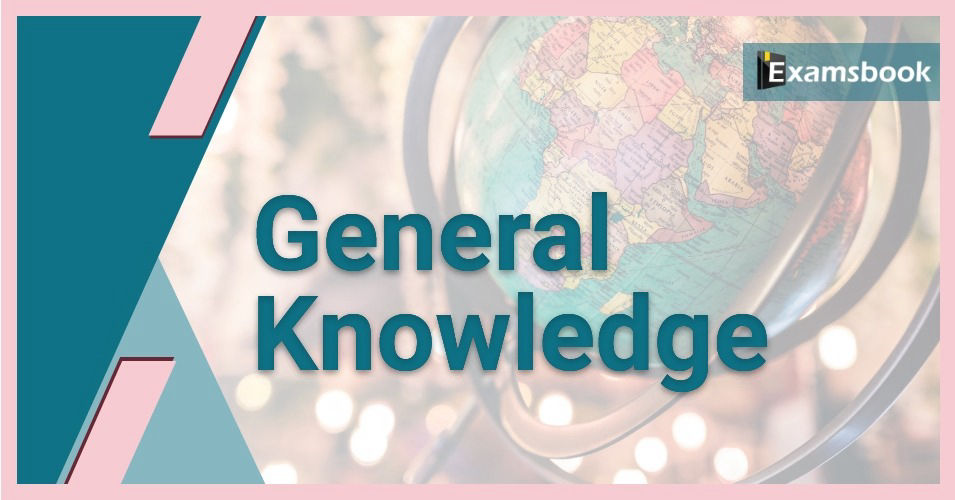General Knowledge (GK) 2023-24: GK Questions, Topics, Mock Test, Practice Quiz

(A) Ministry of Defence
(B) Ministry of Home Affairs
(C) Ministry of External Affairs
(D) Ministry of Finance
Correct Answer : A
Explanation :
Ministry of Defence launched a mobile app 'RDP India 2019' on 26 January 2019. The aim of the app is to show the highlights of the Republic Day event, not only to the spectators at Rajpath, New Delhi but also to the general public all over the world. This app contains information about the Parade on Rajpath, New Delhi, including Order of the March, details of the tableaux presented etc.
World Teacher's Day is celebrated on which of the following days?
(A) January 10
(B) 12 March
(C) 5 October
(D) 15 April
Correct Answer : C
Explanation :
World Teachers' Day is held annually on 5 October to celebrate all teachers around the globe.
________ has received the ICAI Award for Excellence in Financial Reporting for the year 2020-21 in the Public Sector Entities category.
(A) RBI
(B) ICICI Bank
(C) RailTel
(D) SBI
Correct Answer : C
Explanation :
RailTel has bagged the ICAI award for excellence in financial reporting for the year 2020-21 in Public Sector Entities Category. The company was adjudged as the winner in the category “plaque”. Financial Reporting includes the preparation and presentation of financial information.
Who has been named as the Business Standard Banker for the year 2020-21?
(A) Sandeep Bakshi
(B) Amitabh Choudhary
(C) Aditya Puri
(D) Shyam Srinivasan
Correct Answer : A
Explanation :
Sandeep Bakhshi, managing director (MD) and chief executive officer (CEO) of ICICI Bank, is the Business Standard Banker of the Year 2020-21 for turning around the private sector lender and changing the perception about it during his tenure of the past three and a half years.
Recently, who has become the first cricket team in the world to play 1000 ODIs?
(A) Australia
(B) England
(C) India
(D) West Indies
Correct Answer : C
Explanation :
The correct answer is India. The Indian cricket team created history on February 06 by becoming the first side in the world to complete the milestone of 1,000 ODIs. The team has two ODI World Cups and a T20 World Cup to their name. India has 519 wins in the 1000 ODI matches that they have played so far.
Which scheme has been launched by the Ministry of Defense for home delivery of medicines?
(A) yoga plan
(B) health plan
(C) action plan
(D) savings plan
Correct Answer : B
Explanation :
The Ministry of Defence (MoD) has launched services for home delivery of medicines for veterans and serving military personnel services under an online medical consultation platform named Services e-Health Assistance and Teleconsultation (SeHAT).
Which bank has won the IBS Intelligence (IBSi) Global Fintech Innovation Awards 2021 with CRMNEXT Solution?
(A) HDFC Bank
(B) Kotak Mahindra Bank
(C) Yes Bank
(D) Axis Bank
Correct Answer : D
Explanation :
Axis Bank & CRMNEXT Solution won the IBS Intelligence (IBSi) Global FinTech Innovation Awards 2021 for the “Best CRM (Customer Relationship Management) System Implementation”. It is one of the most prominent awards for global bankers and IT (Information Technology) consultants across the world.
On which day "World Pangolin Day" is celebrated every year?
(A) on the third Saturday of February
(B) on the third Sunday of February
(C) on the third Monday of February
(D) on the third Wednesday of February
Correct Answer : A
Explanation :
World Pangolin Day is observed annually on the third Saturday in February, and this year it falls on February 18. It is a day with the goal to remember and celebrate pangolins, raise awareness, and fight against global pangolin capture in Africa and Asia.
Which state/UT has launched a first-of-its-kind Quick Response (QR) code-based mechanism to authenticate and label handmade carpets?
(A) Arunachal Pradesh
(B) Nagaland
(C) Jammu and Kashmir
(D) Uttarakhand
Correct Answer : C
Explanation :
Kashmir: Governor Manoj Sinha launches QR code-based mechanism for certification, labelling of handmade carpets of J&K | Jammu News - Times of India.
In Phase I, banks will transfer 15 NPA accounts (stressed assets) worth _________ to National Asset Reconstruction Company Limited (NARCL) in FY22.
(A) Rs 25,000 crore
(B) Rs 75,000 crore
(C) Rs 82,845 crore
(D) Rs 50,000 crore
Correct Answer : D
Explanation :
Banks have finalised plans to transfer 15 Non-Performing Asset (NPA) accounts worth ₹50,000 crore to the National Asset Reconstruction Company Ltd. (NARCL), or the 'bad bank' set up to help resolve the stress by the end of this financial year.



